

The Final Fred Files
OK, race fans, here's my final installment of the Fred Files, select images from a CD offered to me by former Division 1 Photographer Fred von Sholly. Fred had only offered them to the National DRAGSTER team as material for our files, and while we have gladly and proudly added them to our ever-growing and valuable libraries, I thought it a shame to relegate them to a file folder without first sharing them.
While I've only been able to show you, through the four installments, a small sampling of the more than 500 images he sent me, they've been a pretty good representation of his varied and talented work from the early 1970s, primarily at East Coast tracks.
Although the 12 images and descriptions below are the last ones that I'll offer here, Fred and I do have a parting gift for you at the end of this column that I am absolutely certain will spin your world upside down. But no rushing ahead to see it, OK? Enjoy the slice of East Coast history below; there's some great and historic stuff here.
 |
Many consider Malcolm Durham to be drag racing's Jackie Robinson, the first black athlete in his field to make it to the big time. Durham's Strip Blazer Funny Cars and Pro Stockers helped break drag racing's color barrier. (One could certainly argue the same case for the Stone, Woods & Cook team, which faced its share of discrimination as well but whose driver, Doug Cook, was white; indeed, for years many fans did not realize that team owners Fred Stone and Leonard Woods were black.) Durham, whose barrier-breaking efforts earned him a spot (No. 46) in NHRA's Top 50 drivers list in 2001, noted "We encountered some problems in the South because those people didn't want to accept us. But for me, being black was actually a plus because it made me unique, and I tried to capitalize on it as much as possible. During the late 1960s, I averaged $800 per appearance, and that made me one of the highest paid drivers in the business." Durham was an early Funny Car campaigner, going from A/FX to Funny Car in 1966 and later into Pro Stock. Check out the interesting location of the fire bottle in this shot.
 |
Durham's efforts inspired other black racers to follow in his footsteps, including Lee Jones, who drove Strip Blazer entries for Durham after his own line of Jet Age Special floppers such as the Chevy-powered '71 Camaro shown here. When Durham began focusing more on his Pro Stock efforts, Jones took over the nitro Funny Car reins up through the middle 1970s.
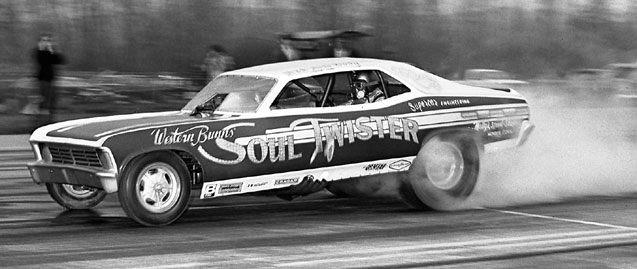 |
Western Bunns was another Durham protégé. He fielded a line of Soul Twister entries out of Danbury, Conn., beginning with this Chevy-powered Nova in 1971. The Nova was followed by a Vega that he ran for several seasons before a 1978 accident in North Carolina left him with a pair of broken legs and ended his career.
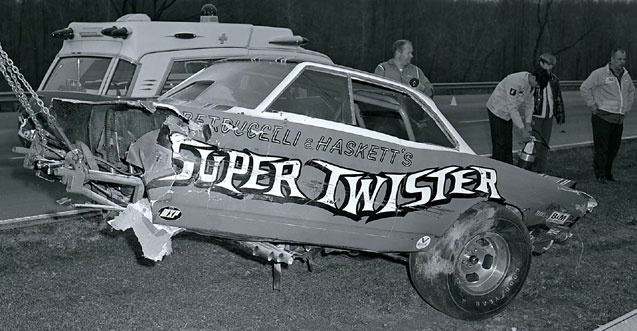 |
Speaking of Twisters, here's a truly twisted Twister, the Petrocelli & Haskett Super Twister Corvair, which obviously met an ugly end. This was their first Funny Car effort after some early gassers, but this car, the former Seaton's Shaker machine, ended up, well, twisted, after a top-end crash at Cecil County. Joe Petrocelli was the wheelman and Bob Haskett his partner; the pair rebuilt with a Camaro Funny Car that also was fairly short-lived.
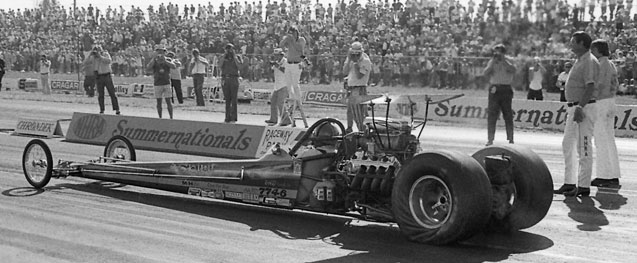 |
Arnie Behling was primarily known as a Funny Car driver who drove for some of the great car owners/drivers such as Arnie Beswick, Eddie Schartman, the Ramchargers, Don Schumacher, Mickey Thompson, and "Big John" Mazmanian (though the latter were short-lived and in the case of Thompson's Maverick, ill-fated), but he earned his biggest moment in the spotlight in Top Fuel in this car at this race: the St. Louis-based Spirit entry of Bruce Dodd at the 1971 Summernationals. Behling won the race, defeating another first-time finalist, Jim Harnsberger, in what still is one of the most unusual outcomes in NHRA history. Harnsberger, a relative unknown from Urbana, Ill., had upset Don Garlits in the quarterfinals at the cost of an engine. He and his team battled New Jersey's severe heat and humidity to thrash together another engine for the semifinals, but he blew that one as well in besting Herm Petersen. As he labored to make yet another swap, he finally collapsed due to heat prostration and was unable to contest the final. After being revived, he did come to the line to watch Behling take this single run. To prove his win was no fluke, Behling reached the final round at the next race, Le Grandnational in Montreal, where he took runner-up honors behind Pat Dakin in what was Dakin's first NHRA final-round appearance.
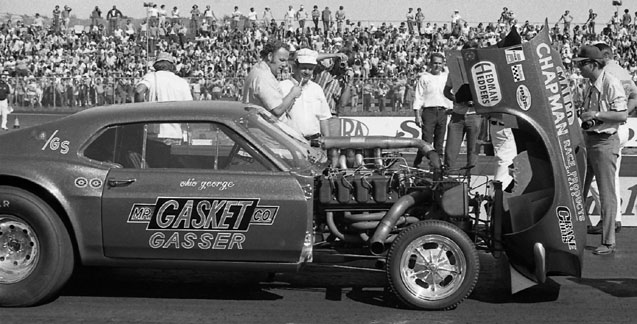 |
At that same 1971 E-town event, George Montgomery accepted the Best Engineered Car award for his turbocharged Mr. Gasket AA/GS Mustang. That's announcer Dave "Big Mac" McClelland getting the inside story from "Ohio George" during the awards presentation on the starting line. Although Montgomery first came to fame behind the wheel of supercharged gassers, he ultimately became known for his turbocharger expertise. This car originally debuted in Indy in 1969 with a blown 427 SOHC engine and won the race. That engine later was swapped for a Boss 429. In mid-1971, he switched to turbo power and won the Gatornationals back to back in 1973 and 1974.
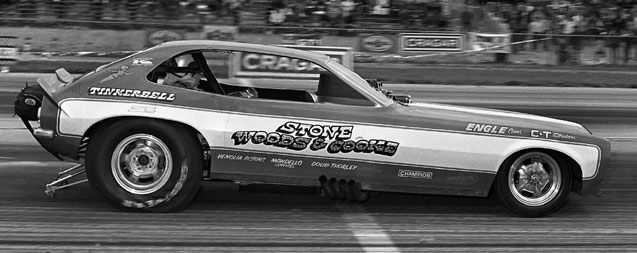 |
Although the Stone, Woods & Cook team was known for its supercharged gassers, it also ran Funny Cars in the 1970s, including this Exhibition Engineering-built Pinto that they dubbed Tinkerbell. It's certainly an odd-looking piece, especially the very short rear deck, and I can’t imagine it handled really well. I believe the driver then was David Ray. Other S-W-C Funny Car drivers included "Mighty Mike" Van Sant, Dale Pulde, Kenny Safford, Doug Cook, and Lyle Fisher.
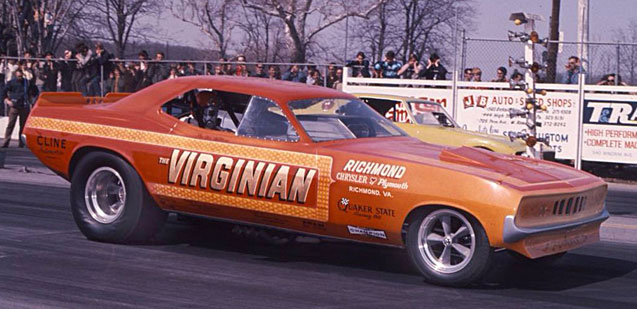 |
"Pee Wee" Wallace was arguably one of the best-known East Coast match racers, and his Virginian race cars (he hailed from Richmond), such as this Barracuda, were always clean, hard runners; he won the Division 1 championship three times. Wallace also drove Billy Holt's Alabamian Funny Cars for a couple of seasons before returning to his own car that he campaigned through the late 1970s.
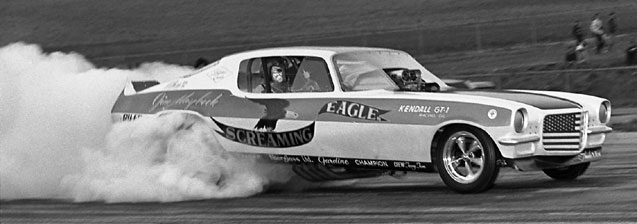 |
Jim Maybeck's Screaming Eagle Funny Cars were primarily East Coast match racers, but his red, white, and blue paint schemes were hits with fans. Maybeck got his star-spangled start in Funny Cars in 1967 with a car he called Patriot, an ex-Bruce Larson USA-1 Chevelle that came pre-painted in those patriotic colors. A hard-running Corvair followed and was the first of the Screaming Eagle cars and gave way to this Rollie Linblad-built Camaro.
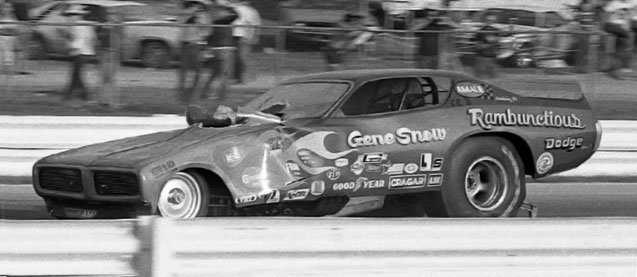 |
Fred also journeyed on occasion to the U.S. Nationals, where he snapped this fine shot in 1971 of "the Snowman," Gene Snow, banging the blower in the lights in his Rambunctious Charger. Note the body distortion from the concussion.
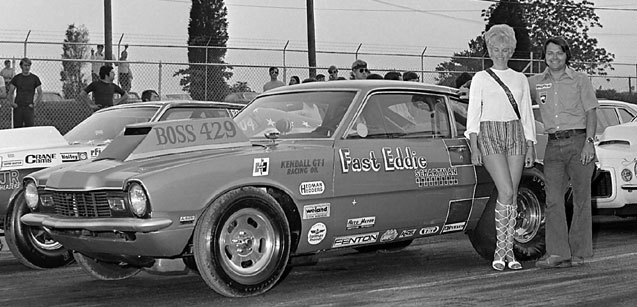 |
As one of the Mercury factory drivers, "Fast Eddie" Schartman had one of the East Coast's most feared Funny Cars in the mid-1960s in his Logghe-built flip-top Comet, versions of which also went to Don Nicholson and Jack Chrisman. Schartman switched to Cougars for the 1968 and 1969 seasons, but after Mercury dropped support of its Funny Car program in 1970, Schartman built this Comet Pro Stocker, fitted with Boss 429 power under the hood. He raced through 1976 – including in Comp, in which he was runner-up at the 1972 Gatornationals in B/Gas trim -- before retiring and purchasing several automobile dealerships.
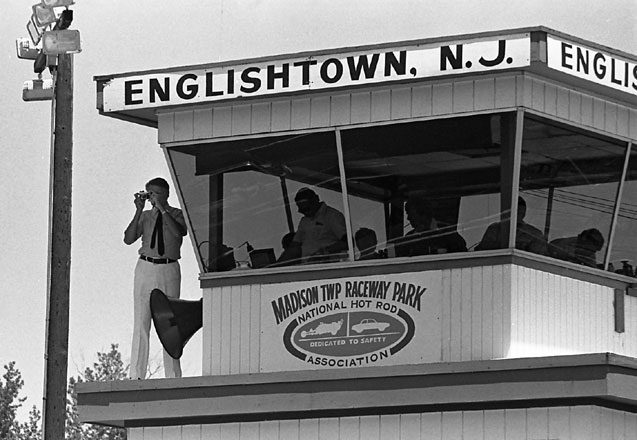 |
And, finally, there's this fun photo of the late, great Wally Parks, also taken in Englishtown in 1971, where he stepped onto the landing of the control tower to snap off a few photos. In addition to being a visionary leader and natural statesman, Parks had a deep love for photography. He shot for himself and for his own enjoyment but just as often to catalog something he saw that he liked or didn’t like to bring to the next meeting, where, as always, his goal was to make NHRA bigger and better.



















































